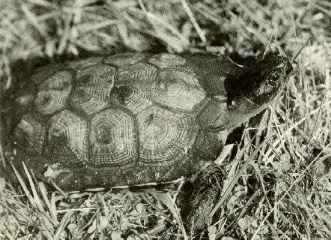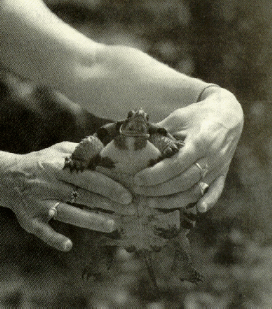
by: John Gilhen, Tom Herman, and Neil Meister
SPRING 1994

Wood Turtles live in streams, but they may be seen in meadows and hayfields as
they search for food. Photo: DNR
All four turtle species that occur in Nova Scotia reach the northeastern limit of their range here. Climate and specific habitat greatly affect their distribution in the province.
The wood turtle can be found primarily in forestry and agriculture areas. It lives mostly in the northeastern mainland and the River Inhabitants in southeastern Cape Breton. Although the climate is favourable in the southwestern part of the province, its habitat is lacking. In other parts of North America, this turtle is threatened or endangered throughout much of its range.
The common snapping turtle and the eastern painted turtle are widely distributed in ponds, lakes, and streams on the mainland. They are common from Halifax and Hants counties southwest to Yarmouth County. They also occur locally in sheltered valleys in the northeastern mainland, but are not found on Cape Breton Island. Although habitat exists there, the number of warm days necessary to successfully incubate the eggs in the nest is insufficient.
The Blanding's turtle is restricted to the Kejimkujik National Park area in southwestern Nova Scotia. People who study amphibians and reptiles refer to this turtle as a post glacial relic. About three to five thousand years ago, when the climate was much warmer here, the Blanding's turtle was more widespread. As the climate gradually cooled to present day temperatures, successful nesting was only possible in the area around Kejimkujik Lake, the warmest area in the province.
The status of the Blanding's turtle population at Kejimkujik National Park is listed as threatened by the Committee on the Status of Endangered Wildlife in Canada (COSEWIC). Although the population is small, it occurs primarily within a protected landscape where land use is controlled. The species is protected within the park by federal statute and outside the park by provincial legislation (Nova Scotia Wildlife Act, 1990).
Deterioration of the wood turtle's habitat, particularly in valleys with prime agricultural land, is a major problem. Nesting beaches disturbed by livestock and construction of cribbing to stabilize riverbanks has resulted in unsuccessful nesting. A population that once thrived on the lower Nictaux River in the Annapolis Valley has decreased to the point that few individuals have been seen in recent years.
In some areas, the wood turtle is commonly called "red legs" because the back of the legs vary in colour from bright orange to red. The underside of the neck and tail are also orange to red. The head, the top and sides of the neck, the tail, and the front of the legs are black. The pyramid-like raised shields of the top of the shell (carapace) are brown with yellow and black streaks. The bottom of the shell (plastron) is yellow with an irregular black blotch on the outside corner of each plate (scute). The female's plastron is flat, while the male's is prominently concave. Adult males are generally larger than adult females. They have a broader head and a longer and thicker tail. The top of the male's shell ranges from 19.7 to 21.6 cm, while the female's top shell ranges from 16.5 to 19.7 cm.
Wood turtles live in slow-moving, meandering interval streams. In winter, they hibernate underwater, along rocks and deadwood on the river bottom. When they first emerge from their hibernating sites in spring, they spend several hours each afternoon laying in the sun on firm, mud riverbanks. By evening, they retreat back to the water to spend the night. This habit of laying on mud banks has earned the species the name mud turtle. During the summer, wood turtles may venture some distance from water to spend the day searching for food. They eat plants, berries, earthworms, slugs, snails, and insects, which they find along riverbanks and roadsides and in meadows and hayfields.
In mid to late June, females usually dig a nest in a sandy gravel bank on a bend in the river. They deposit 8 to 10 leathery eggs. They also nest in artificial sites, such as gravel road banks, gravel pits, and gardens, and are often seen crossing roads to reach these sites. Since most artificial sites are farther from the stream than natural sites, the hatchlings have less chance of migrating to aquatic nurseries without being killed by predators or automobiles.
Wood turtles should not be taken home for a pet. Removing adults from their native streams or as they cross roads is seriously threatening their population. These turtles are kept for a time and then escape or are released, often many kilometres form their original native habitat. Most of them probably wander about for the rest of their lives and are lost from the breeding population.
It takes approximately 15 years for a wood turtle to reach maturity and breed. Although individuals may live for more than 30 years, the chance of a hatchling living to adult life is very slim. Therefore, every adult turtle is important in maintaining a stable population.
 Predators, particularly raccoons, dig up and eat 9 out of every 10 eggs in a nest. They also consume many of the small soft-shelled hatchlings in the shallow waters that serve as nurseries. Adult turtles must also cope with predators, but relatively few die. However, it is not uncommon to find one or two limbs chewed off by predators such as otters. Turtles have survived this way for tens of millions of years. It is only recently that humans have intervened and changed the rules.
Predators, particularly raccoons, dig up and eat 9 out of every 10 eggs in a nest. They also consume many of the small soft-shelled hatchlings in the shallow waters that serve as nurseries. Adult turtles must also cope with predators, but relatively few die. However, it is not uncommon to find one or two limbs chewed off by predators such as otters. Turtles have survived this way for tens of millions of years. It is only recently that humans have intervened and changed the rules.
In 1993, the three authors of this article formed "Turtle Watch", a committee studying the status of the wood turtle in Nova Scotia. If anyone finds a wood turtle wandering about, please contact one of the authors. The displaced turtle will be examined by a veterinarian before being relocated to its natural habitat, where it can resume a productive natural life.
In the spring of 1994, the committee will be distributing questionnaires through local fish and wildlife, naturalist, and outdoor recreation groups to seek information from the public about the status of wood turtles in areas were they are known to have occurred in the past. If you would like to receive a questionnaire directly or wish to become involved in another way, please contact the committee at:
| Turtle Watch c/o Centre for Wildlife and Conservation Biology Acadia University Wolfville, NS B0P 1X0 Phone: 542-2201 ext. 1469 Fax: 542-3466 |
The committee will also be placing educational posters about the life and plight of wood turtles along streams where they live. It's important that those who are out in the wilderness, such as anglers, campers, canoeists, and hikers, leave the turtles in the wild streams and adjacent to landscapes where they belong.